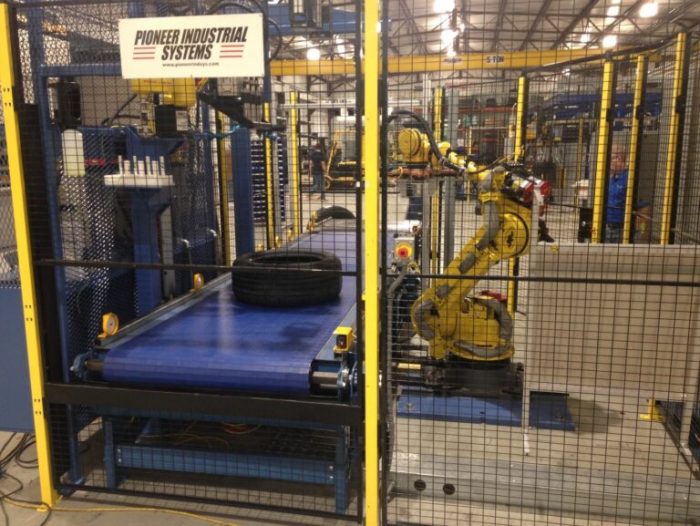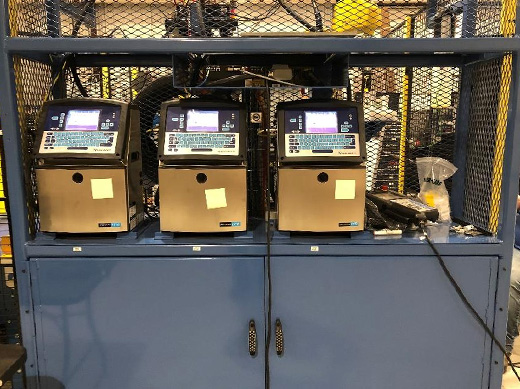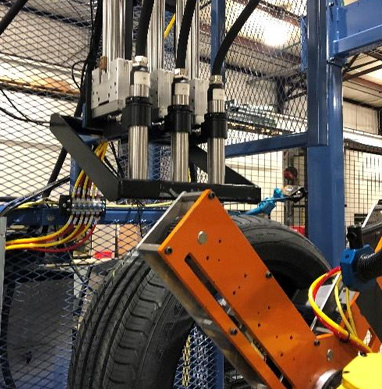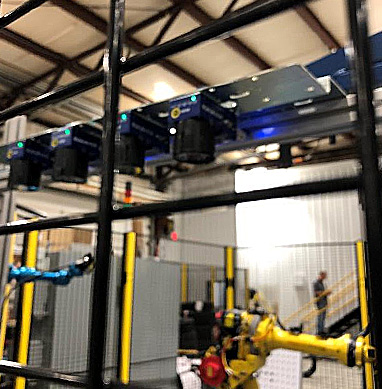OEM Tire Marking Case Study
Customer, Challenge & Risks
Our customer was a corporate engineer of a global tire manufacturer. She wanted Pioneer Industrial Systems help to make supplying tires to OEM requirements easier. Finished tires that meet OEM uniformity requirements must be specifically marked for delivery with conicity stripes and highpoint location. The challenge to Pioneer was to provide a new piece of equipment where tires could be conveyor fed with automated handling and marking systems that reduced labor. Meeting customer equipment specifications and maintainability standards were crucial, but having done other machines for this customer, we were already on top of this.
Tire manufacturers who supply tires to the OEM market face rigorous tire performance criteria. First, they must design a tire that meets the performance requirements set by the vehicle. This is a balance of rolling resistance, tire noise, wet and dry traction, treadwear, subjective handling, and ride resulting in a unique SKU. Once the engineering approval is achieved the tire moves into production where it will again face rigorous uniformity and quality specifications. To guarantee compliance tire makers will screen 100% of the cured tires gaining uniformity data on each tire. Once the uniformity data is known for the tires that pass, they must be marked in a manner that facilitates mounting to the wheel and compiled into a set of four tires for assembly to the vehicle on the production line.
High point refers to the location of the first harmonic of radial force variation (R1H). Radial force variation (RFV) is a test where an inflated tire is rolled against a wheel with force measuring capability. The tire is loaded against the wheel and fixed in position, as the tire rolls it measures the radial force exerted on the load wheel. A perfect tire will measure a constant force, say 1000 lbs. typically, this force will vary, for example +/- 990 to 1010 lbs. = 20 lbs. of force variation. OEM’s know that excessive force variation creates a ride disturbance and set limits for the tire manufacturers. They also know that wheels will have similar variation (especially steel wheels). To minimize ride disturbance, they match mount the tire to the wheel, so the forces tend to cancel each other. Therefore, the high point mark is required. Each OEM specifies the required color and dot size.
Conicity is also measured on the same uniformity machine. It is a measure of the tires tendency to like a cone. Turn an empty coffee cup on its side and roll it and you will see it rolling away from a straight line. Tires will excessive conicity will be felt as a pull in the steering wheel when driving in a straight line. Automakers address this effect in two ways. One is to place tight limits on the magnitude of the force, the other is to match tires in sets so that when mounted on the car the forces offset each other. This drives the conicity striping requirement. First tires are sorted into batches by (+), (-) values then it is a manual operation where a person marks the tread face with a crayon using the guidelines set by the OEM for color and quantity.
Solution
All modern tire plants place barcodes on each tire. Each tires uniformity data is collected and stored on a data base by barcode. This is a key enabler for our solution. Tires enter the marking cell and the barcode is read, pulling the relevant data. The system then selects the specific OEM marking requirements. A robot arm then picks up the tire and presents it to array of painting heads where the conicity stripes and high point mark are applied. Following the marking operation, the tire is presented to a vision system that verifies the markings are in the correct location, color, and quantity. Once verified the tire is placed on the exit conveyor for sorting and delivery preparation.
After providing the customer with a proposal that included advantages of our robotic solution and cycle time analysis, the customer was able to sell the tire marking machine to leadership. It was approved within the budget, met the required specifications, and a PO was issued.

Pioneer started its defined Machine Building Process. This process involved detailed engineering kickoffs, where we worked closely with the customer on getting signed approvals for mechanical layouts, electrical schematics, and programming structure. As the project came together on the floor, consistent updates were sent to the customer. Once it was completed, the customer came on-site for a full day of runoff at Pioneer’s facility, putting the machine through its paces and completing both the customer’s checklist, maintainability standards, and Pioneer’s own internal checklist. The customer had the chance to make a few minor tweaks, but due to the communication at the front and throughout the project, minimal changes were required before shipment. After the customer runoff, the machine was disassembled, shipped, and Pioneer’s engineer went on-site to supervise the installation of the equipment. Since the design was modular, the installation was completed in only five days. The engineer then stayed on-site the following week to connect our system to the plant conveyors and higher-level server and a few days of commissioning and training for the operator, maintenance, and plant engineer.
The customer was given with machine drawings, a detailed machine manual, the latest copies of the robot and PLC programs, and a spare parts list all on a memory stick. A 6-month complimentary maintenance was scheduled, in which the fluid system was recalibrated, spray gun cleaned and adjusted, and the system is given a thorough inspection. A trip report was completed and submitted to the customer with a quote for a return service visit and any additional spare parts required.
Outcomes of Success
Overall, the project was very successful. The system was installed on schedule. Tires now come off the processing line ready to ship to the respective OEM. The task of finding pallets of tires in the warehouse and having to mark them with a crayon has been eliminated freeing operators to focus on more value-added tasks. The markings are clear eliminating customer complaints of hard to read while staging for the tire wheel mounting operation. The OEM receives sets of tires that provide their customers smooth rides free of pulls and roughness.
The plant engineer was involved throughout the project, so she was always aware of status, any obstacles, and felt comfortable throughout the entire process.
The initial project is now in the R&D center for production readiness, with future machines planned for dispersal to multiple tire plants.
Material Handling
Paint, Dispense, & Spray
Robotics Integration
Marking
Software & Data Integration
Vision Applications
OEM Tire Marking Feature Highlights












